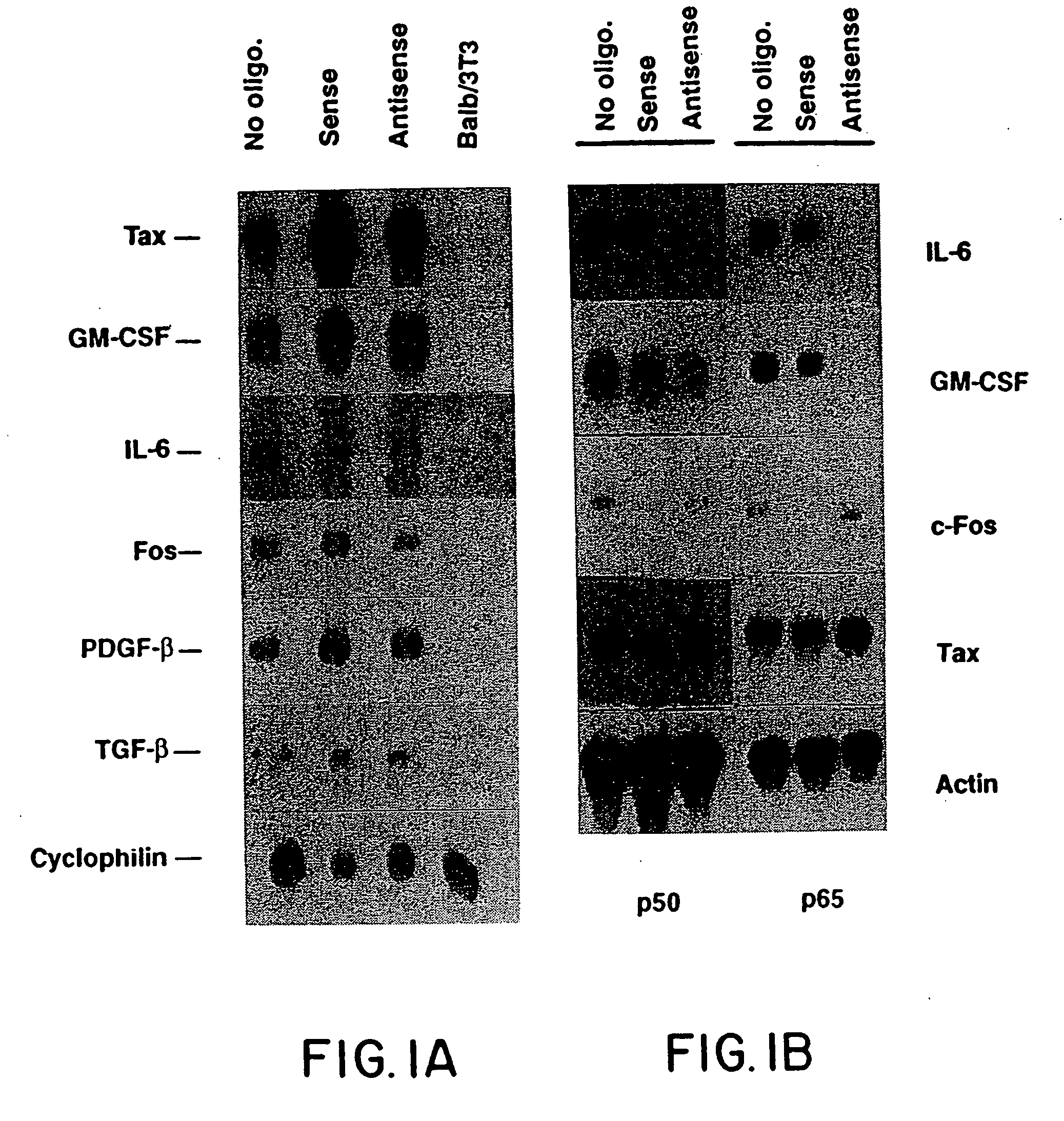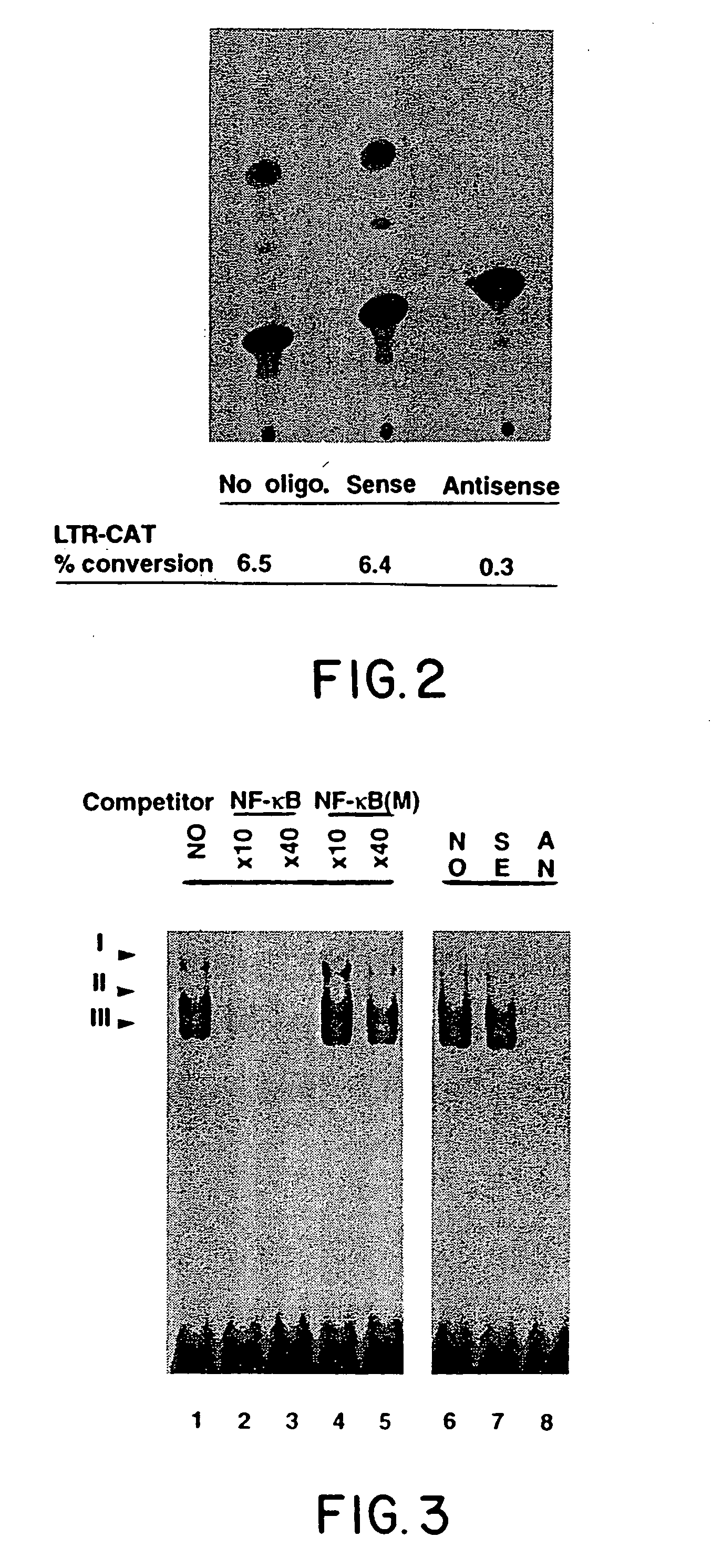Suppression of nuclear factor-kappaB dependent processes using oligonucleotides
a technology of oligonucleotides and nuclear factor kappab, which is applied in the field of inhibiting disorders, can solve problems such as inhibiting progression or establishment of disorders, and achieve the effects of avoiding toxic aspects, low efficiency and high biocompatibility of prior art methodologies and compositions
- Summary
- Abstract
- Description
- Claims
- Application Information
AI Technical Summary
Benefits of technology
Problems solved by technology
Method used
Image
Examples
example 1
Antisense Inhibition of Tumor Cells In Vitro
A. Preparation of Oligonucleotides
[0043] Sense and antisense oligodeoxynucleotides (ODNs) were synthesized by the phosphoramide method on an ABI automated synthesizer (Foster City, Calif.). The phosphothioate (PS) sulfurization modification (Stein, et al., Nucleic Acids Res., 16:3209, 1988) was performed during synthesis, where TETD and acetonitrile were substituted for the usual iodine, pyridine and water during the oxidation step. ODNs were purified according to published procedures (Miller, et al., J. Biol. Chem., 255:9659, 1980).
[0044] One set of sequences was selected to be complementary to the transcript encoded by the HTLV-I LTR-tax cassette which had previously been used to generate transgenic mice (Nerenberg, et al., Science, 237:1324, 1987). The antisense sequence was GAAGTGGGCCATGTGGA*A*G (location 718-737 on HTLV-I LTR-tax construct) which included the AUG initiation codon (underlined) and sense sequence was CTTCCACATGGCCCA...
example 2
Antisense Inhibition of Tumor Growth In Vivo
[0058] Studies were performed on the effects of ODN mediated suppression of unmanipulated line B cells which were transferred to syngeneic C57Bl / 6 mice. Once tumors were established (7 days after injection in the hind limb), mice were treated with 3 intraperitoneal (IP) injections at 3 day intervals of 40 μg / g of sense and antisense ODNs as described by Goodchild, et al. (T. A. Libermann, et al., Mol. Cell. Biol., 10:2327, 1990). Western blot analysis of tumors exposed to tax antisense ODN treatment showed virtually complete suppression of tax expression at the 40 μg / g dose. As previously seen above in in vitro studies, no perturbation in growth rate of tumors was seen in the animals treated with tax antisense ODNs. Treatment with antisense ODN to NF-κB had dramatically different effects. FIG. 5 shows a typical comparison of typical matched mice either 15 days after treatment with sense (left) or antisense (right) ODNs to p65. In each cas...
example 3
Antisense NF-κB ODNs Prevent LPS Mediated Death
[0062] In order to compare the effects of NAC or NF-κB AS-ODNs on the toxic manifestations of LPS induced septic shock, survival rates for the different treatment groups of mice were compared. This data is summarized in FIG. 6.
[0063] LPS-induced lethality. In vivo LPS challenge was performed according to the modified methods of Broner et al, Critical Care Medicine 16:848, 1988; and Peristeris, et al., Cellular Immunology, 140:390, 1992. A total of 35 C57BI / 6 mice (body weight 25-35 g) were studied in three treatment groups: 1) 10 mice were treated with LPS followed by two mock injections of saline. 2) 10 mice were pretreated with NAC 12 hours and ½ hour prior to innoculation with LPS. 3) 10 mice were pretreated with NF-κB antisense ODNs 20 hours and ½ hour prior to LPS, and 5 mice were treated 20 and ½ hours prior to LPS with an irrelevant HTLV-I specific antisense ODN (Kitajima, I., et al., J. Biol. Chem. 267: 25881, 1992) as a contr...
PUM
| Property | Measurement | Unit |
|---|---|---|
| melting temperature | aaaaa | aaaaa |
| concentration | aaaaa | aaaaa |
| affinity | aaaaa | aaaaa |
Abstract
Description
Claims
Application Information
 Login to View More
Login to View More - R&D
- Intellectual Property
- Life Sciences
- Materials
- Tech Scout
- Unparalleled Data Quality
- Higher Quality Content
- 60% Fewer Hallucinations
Browse by: Latest US Patents, China's latest patents, Technical Efficacy Thesaurus, Application Domain, Technology Topic, Popular Technical Reports.
© 2025 PatSnap. All rights reserved.Legal|Privacy policy|Modern Slavery Act Transparency Statement|Sitemap|About US| Contact US: help@patsnap.com



